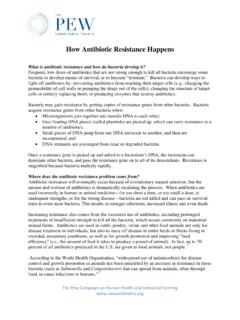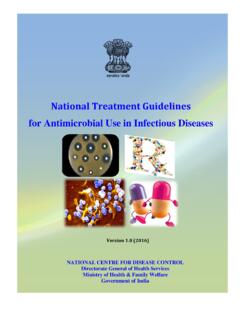Transcription of Urinary Tract Infections - Columbia University
1 1 Urinary Tract Infections Magdalena Sobieszczyk, MDClinical Scenario #1 23 woman presents to her doctor complaining of 1 day of increased Urinary frequency, dysuria and sensation of incomplete voiding She is otherwise healthy, takes no medications,and is sexually active, using spermicide-coated condoms for contraception. She says she does not have fever, chills, vaginal discharge, or flank pain Sexually active with one partner, no hx/o sexually transmitted diseases2 Clinical Scenario #1 She looks a little uncomfortable but is afebrile, with a normal blood pressure Her abdominal exam is notable for mild suprapubic tenderness, no RUQ tenderness, no costovertebral tenderness Pelvic exam is deferredClinical Scenario #1 : Labs Urinalysis: pyuria (WBC too numerous to count), RBC and bacteria present Urine dipstick: positive leukocyte esterase and nitrite Urine culture: not done Patient receives 3 days of TMP/SMX for UTI3 Gram stain of urine shows numerous Gram-negative rods.
2 From this urine specimenUrinary Tract Infections Definitions Clinical Symptoms and Diagnosis Microbiology and Epidemiology Pathogenesis Host Factors Bacterial Factors Clinical Scenario Treatment and Prevention4 UTI: Definitions Lower UTI: cystitis, urethritis, prostatitis Upper UTI: pyelonephritis, intra-renal abscess,perinephric abscess (usually late complications ofpyelonephritis) Uncomplicated UTI Infection in a structurally and neurologically normal Urinary Tract . Simple cystitis of short (1-5 day) duration Complicated UTI Infection in a Urinary Tract with functional or structural abnormalities (ex. indwelling catheters and renal calculi). Cystitis of long duration or hemorrhagic : Clinical Symptoms and Presentation Cystitis in the adult: Dysuria, Urinary urgency and frequency, bladder fullness/discomfort Hemorrhagic cystitis (bloody urine) reported in as many as 10% of cases of UTI in otherwise healthy women Pyelonephritis (upper UTI) in the adult: Fever, sweating Nausea, vomiting, flank pain, dysuria Signs and symptoms of dehydration, hypotension A history of vaginal discharge suggests that vaginitis, cervicitis, or pelvic inflammatory disease is responsible for symptoms of dysuria (pelvic examination) Important additional information includes a history of prior sexually transmitted disease (STD) and multiple current sexual partners.
3 UTI in children: < 2 years - enuresis, fever, poor weight gain > 3 years - dysuria, lower abdominal pain5 Diagnosis of UTI U/A microscopic examination WBC, RBC Presence of bacteria Urine dipstick test: rapid screening test leukocyte esterase test Nitrate nitrite test Indications for urine culture Pyelonephritis Children, pregnant women Patients with structural abnormalities of the Urinary tractIndications for Evaluating the Urinary Tract Children ultrasound, IVP, CT scan Bacteremic pyelonephritis not responding to therapy ultrasound, IVP, CT scan Nephrolithiasis or Neurogenic Bladder Ultrasound, CT, or IVP with post-voiding films Men with 1stor 2ndinfection Careful prostate examination Ultrasound or IVP with post-voiding films6 Etiology of Uncomplicated UTI in Sexually Active WomenE. coli 79%S. saprophyticus11%Klebsiella 3%Mixed 3%Proteus 2%Enterococcus 2%Other 2%Microbial Species Most Often Associated with Specific Types of UTI s8%15%0%0%S.
4 Epidermidis28%1%0%0% *11%10%5%3%Mixed9%20%0%0%Ps. aeruginosa7%22%0%2% mirabilis0%1%0%11%S. saprophyticus24%32%89%79% UTIC omplicated UTIA cute uncomplicated pyelonephritisAcute uncomplicated cystitisOrganism*Serratia, Providencia, Enterobacter, Acinetobacter, Citrobacter7 UTI: Epidemiology and Risk Factors by Age GroupAll of the above; Urinary catheters (35%)Estrogen deficiency and loss of lactobacilli (40%)>65 Prostate hypertrophy, obstruction, catherization(20%)Gynecologic surgery, bladder prolapse (35%)36-65 Anatomic, insertive anal intercourse ( ) Sexual intercourse, spermicideuse, previous UTI (20%)16-35 Vesicoureteral reflux ( )Vesicoureteral reflux ( )6-15 Congenital abnormalities, uncircumcised penis ( )Congenital abnormalities,Vesicoureteral reflux ( )1-5 Anatomic/functional abnormalities (1%)Anatomic/functional abnormalities (1%)< 1 Males(% Prevalence)Females (% Prevalence)Age in yearsPathogenesis of UTI Hematogenous Route Ascending Route Colonization of the vaginal introitus Colonization of the urethra Entry into the bladder Infection8 IntroitalColonizationGut FloraCystitis (Urethritis)PyelonephritisBladder inoculationUrethralColonizationSexual ActivityUTI in Women.
5 Factors Predisposing to Infection Short urethra Sexual intercourse & lack of post coital voiding Diaphragm, spermicide use Estrogen deficiency P1blood group - upper UTI9 Host Factors Predisposing to Infection Extra-renal obstruction Posterior urethral valves Urethral strictures Renal calculi Incomplete bladder emptying Neurogenic bladder Immunocompromised individuals ( DM, transplant recipients) Bacterial Virulence Factors-I Enhanced adherence to receptors on uroepithelial cells Type 1 fimbriae:mediate binding to uroplakins, mannosylated glycoproteins on the surface of bladder uroepithelial cells P fimbriae:bind to galactose dissaccharide on the surface of uroepithelial cells and to P blood group antigen ( D-galactose-D-galactose residue) on RBCs 97% of women with recurrent pyelo are P1 blood group (+) Higher prevalence of P-fimbriated cystitis-causing strains than in strains from asymptomatic persons (60% vs.)
6 10%) Phase variation: Type 1 fimbriae increase susceptibility to phagocytosis, P-fimbriae block phagocytosis Type 1 down-regulated, Type P upregulated in strains that cause upper- Tract Infections (PAP gene expression triggered by temperature, [glucose], concentration of certain amino acids)10 Electron microscopic view of an the fimbriae (pili) bristling from the bacterial cell wall11 Bacterial Virulence Factors-II Flagella- enhanced motility Production of hemolysin induces pore formation in cell membrane Production of aerobactin (a siderophore) iron acquisition in the iron-poor environment of the Urinary tractAntibacterial Host Defenses Urine flow and micturition Urine osmolality and pH Inflammatory response (PMNs, cytokines) Inhibitors of bacterial adherence Bladder mucopolysaccharides Secretory immunoglobulin A12 The pathophysiology of infection byuropathogenic Escherichia coli in bladder epithelial cellsFrom Cohen & Powderly: Infectious Diseases, 2nded.
7 , 200413 Clinical Scenario #2 43 woman with DM presents to the ER complaining of chills, nausea and low back pain for the past 2 days. Earlier in the week she developed increased Urinary frequency and dysuria. Recognizing the symptoms of UTI she took two days of TMP/SMX but was unable to finish treatment because of nausea and vomiting Past medical history is notable for frequent UTIs treated with TMP/SMX and a history of Diabetes Mellitus No hx/o STDs, no vaginal dischargeClinical Scenario #2 She looks unwell and appears uncomfortable She is febrile to , tachycardic to 100 with a BP 100/60 On exam her mucous membranes are dry; there issuprapubic tenderness, and severe right flank and right costovertebral tenderness Urinalysis, Urine microspic examination and urine culture are performed: pyuria, hematuria, bacteriuria Blood cultures are drawn Patient is admitted to the hospital for IV antibiotics and pain management14 Clinical Scenario #2 The next day, urine and blood cultures show Gram-negative rods After 72 hours of hydration and intravenous antibiotics your patient is still febrile and repeat urine examination is still notable for pyuria and bacteriuria You are concerned about Urinary obstruction intrarenal/perinephric abscess infection with resistant organism Microbiology lab informs you that the the pathogen is an to fluoroquinolones, resistant to TMP/SMX Renal CT is notable for a large renal abscess Diagnosis.
8 Pyelenephritis complicated by a renal abscess in a diabetic patient 15 UTI: Upper Tract Disease Symptoms suggestive of upper Tract disease (pyelonephritis): Fever (usually greater than 101oF.), Nausea, vomiting, and Pain in the costovertebral areas Urinary frequency, urgency and dysuria Renal abscess: patients with urnary Tract abnormalities, diabetic patients Evaluation: urine culture, +/- blood cultures, Imaging if no improvement Microbiology: , and Citrobacter, Pseudomonas aeruginosa, Enterococci, Staphylococcusspp. Initial therapy: intravenous antibiotics for 10-14 days (perinephric abscess treat longer, +/- drainage)16 Pyelonephritis: glomerular hemorrhagePyelonephritis - papillary necrosis17 Treatment: General Principles Quantitative cultures may be unnecessary before treatment of typical cases of acute uncomplicated cystitis.
9 Culture urine in patients with upper UTI, complicated UTI, or with treatment failure. Susceptibility testing is necessary in all recurrent or complicated Infections , perhaps not for uncomplicated cases. Identify or correct factors predisposing to infection Obstruction, calculi Diabetic patients who are at risk for recurrent Infections , pyelonephritisand perinephric abscesses Recurrent Infections common in young women (20% by 6 months). Majority are exogenous Infections rather than failure to cure initial infection Duration of therapy depends on the site and duration of the Antimicrobials Choice of antimicrobial agents Primary excretion routes through the Urinary Tract Achieve high concentration in urine and vaginal secretions Inhibit , the primary pathogen Short course (3-day) therapy for uncomplicated Infections Longer duration (10-14 days) for complicated infection ( pyelonephritis) Oral vs.
10 Intravenous agents (TMP/SMX, Fluoroquinolones)18 Cohen & Powderly: Infectious Diseases, 2nded., 2004 Cohen & Powderly: Infectious Diseases, 2nded., 200419 Treatment of Asymptomatic Bacteriuria Pregnant women Patients with neurological or structural abnormality of the Urinary Tract Patients undergoing urologic surgeryCohen & Powderly: Infectious Diseases, 2nded., 200420 Prevention of Recurrent UTI Risk factors for recurrent uncomplicated UTI P1 blood group positive; postmenopausal status; diabetes Recent antimicrobial use Behavioral risk factors (spermicide use, new partner, first UTI <15 ) Prevention Strategies Contraception Postcoital voiding and increased fluid intake Cranberry juice (sexually active women with previous UTI) Antibiotic prophylaxis >2 symptomatic UTIs within six months or >3 over 12 months Postcoital prophylaxis vs.













